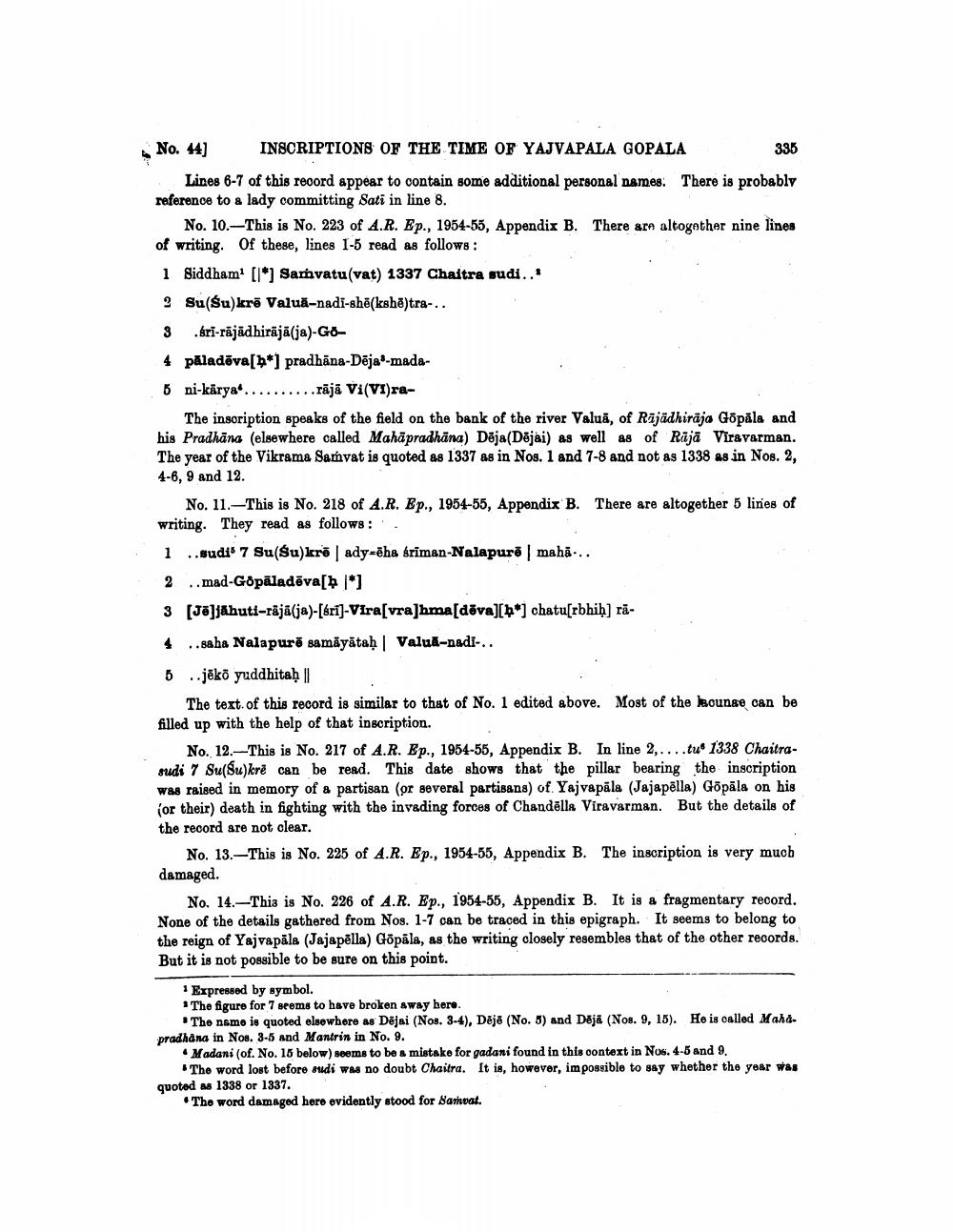________________
No. 44] INSCRIPTIONS OF THE TIME OF YAJVAPALA GOPALA
335 Lines 6-7 of this reoord appear to contain some additional personal names. There is probably reference to a lady committing Sati in line 8.
No. 10.-This is No. 223 of A.R. Ep., 1954-55, Appendix B. There are altoynther nine lines of writing. Of these, lines 1-5 read as follows: 1 Siddham [I*] Samvatu(vat) 1337 Chaitra sudi.. 9 Su(su)krē Valuă-nadi-shö(kshē)tra-.. 3 .Sri-rājādhirājā(ja)-Go4 paladēva[h*) pradhāna-Dēja -mada5 ni-kārya...........rājā Vi(VI)ra
The inscription speaks of the field on the bank of the river Valuă, of Rījādhiraja Gopāla and his Pradhāna (elsewhere called Mahāpradhāna) Dēja(Dējai) as well as of Räjä Viravarman. The year of the Vikrama Samvat is quoted as 1337 as in Nos. 1 and 7-8 and not as 1338 as in Nos. 2, 4-6, 9 and 12.
No. 11. This is No. 218 of A.R. Ep., 1954-55, Appendix B. There are altogether 5 lines of writing. They read as follows: 1 ..Budi' 7 Su(su)kro | ady=ēha sriman-Nalapuro maha... 2 ..mad-Gopāladēva[*] 3 []jahuti-räjā(ja)-[ári)-Vira[vra]hma[dova][**] chatu[rbhih) rā
..saha Nalapurē samāyātaḥ| Valuā-nadi-.. 5 ..jēko yuddhitaḥ ||
The text of this record is similar to that of No. 1 edited above. Most of the lounge can be filled up with the help of that inscription.
No. 12.-This is No. 217 of A.R. Bp., 1954-55, Appendix B. In line 2,....tu 1338 Chaitrasudi 7 Su(Su)kre can be read. This date shows that the pillar bearing the inscription Was raised in memory of a partisan (or several partisans) of Yajvapāla (Jajapēlla) Gopāla on his (or their) death in fighting with the invading forces of Chandella Viravarman. But the details of the record are not clear.
No. 13.-This is No. 225 of A.R. Ep., 1954-55, Appendix B. The inscription is very much damaged.
No. 14.-This is No. 226 of A.R. Ep., 1954-55, Appendix B. It is a fragmentary record. None of the details gathered from Nog. 1-7 can be traced in this epigraph. It seems to belong to the reign of Yajvapäla (Jajapëlla) Göpāla, as the writing closely resembles that of the other records. But it is not possible to be sure on this point.
1 Expressed by symbol. * The figure for 7 seems to have broken away here.
The namo io quoted olaowbore as Dējai (Nos. 3-4), Dējē (No. 5) and Daja (Nos. 9, 15). Ho is called Maha. pradhana in Nos. 3-5 and Mantrin in No. 9.
• Madani (of. No. 16 below) seems to be a mistake for gadani found in this context in Nos. 4-5 and 9.
The word lost before sudi was no doubt Chaitra. It is, however, impossible to say whether the year was quoted as 1338 or 1337.
• The word damaged here evidently stood for Samval.




